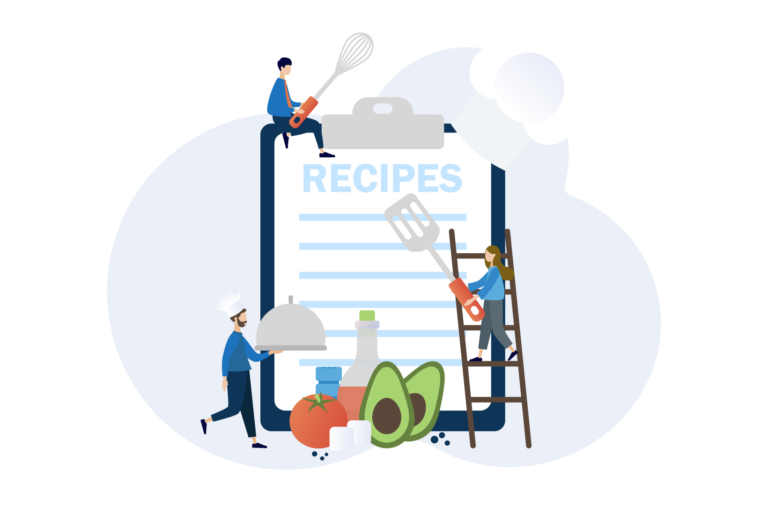There’s a particular art to recipe writing, especially if you’re working as a food blogger or online chef. After all, the content must be the perfect mix of informative and engaging to build an audience and receive the kind of engagement you deserve.
Individual creators and larger businesses within the food industry encounter many challenges when writing a recipe. For example, they must ensure that:
- They are creating unique recipes.
- Their recipes are accurate and free from errors.
- They write engaging content, from the introduction to the closing remarks.
- Recipes are regularly updated.
- The website is visually appealing and user-friendly.
In this article, we’ll delve deeper into the world of recipe writing so you know precisely how to write winning recipes for your food blog or business. If you’re a WordPress user, we’ll also show you how to utilize the WP Recipe Maker plugin to write the ultimate recipe!
How to write winning recipes
Choose a consistent format for your recipes
While the content featured within your recipes is undoubtedly important, it’s also crucial that you choose a consistent format for your recipes. This ensures the content is easy to read, understand, and digest, improving user experience.
You can maintain consistency in format across different recipes in many ways. For example, you should:
- Create a list of ingredients that are based on the order of use.
- Use the same units of measurement in each recipe.
- Use the same language throughout recipes, especially when it comes to using abbreviations.
- Organize your recipes according to specific criteria so that people can easily find them on your website – nationality, type of dish (breakfast, lunch, dinner, dessert), dietary requirements (vegan, vegetarian, gluten-free).
However, the easiest way to achieve this consistency with an extensive database of recipes is by using the WP Recipe Maker’s recipe cards.
These recipe cards can automatically arrange the information into a standardized layout, which ensures uniformity across your recipe website and improves site accessibility.

There are a range of pre-built templates based on how you’d like your recipes to look. However, you can create a more bespoke recipe template with the Template Editor.
For example, the DivasCanCook blog (pictured below) has included useful options such as adjusting the scale of the recipe, print and pin buttons, and a “jump to recipe” button. The color scheme is consistent with the rest of their website, and since it’s a dessert, it also has chill time included in the info section of the recipe.

While the DefinedDish utilizes a similar format, they’ve also added an ingredients checklist to help users keep track of what they need and create a shopping list.

The great thing about these templates is that they can be seamlessly integrated with your website’s design, even if you use a page builder like Elementor.
Write for your target audience
As with any form of content curation, you must thoroughly understand your target audience before writing. After all, your readership influences your content in various ways, whether it alters your tone of voice or the complexity of the dishes you create.
For example, if you were writing a recipe blog aimed at first-time cooks or bakers, you’d likely include simple yet detailed instructions. In contrast, blogs for more experienced cooks will contain more complex ingredients and methodologies and can afford to be more straight to the point.
Your blog’s audience may be based upon factors such as:
- Cuisine
- Recipe complexity
- Dietary preferences (Vegetarian, vegan, gluten-free)
- Cultural considerations
Ideally, the more specific your target audience, the better, as this allows you to cater to a particular niche instead of getting your recipes lost among the crowd. However, there are some things you should always take into consideration when writing.
For example, you should always offer ingredient substitutions for common allergens and dietary requirements, as this will make your content more accessible. If you’re cooking recipes from different cultures, you should treat this task with the respect and sensitivity it deserves. This involves respecting traditional cooking methods, using the correct names (and spellings) for dishes and ingredients, and acknowledging the cultural origins of the recipe.
Include a catchy title
An intriguing title can set expectations for your recipe, capture your reader’s attention, and encourage them to engage further with this content.
The key to writing a catchy title for your recipes lies in finding the balance between being descriptive and distinct. For example, it should clearly outline the dish while appealing to the audience’s curiosity. The below recipe title from Divas Can Cook is an excellent example of this:

The use of the adjective, best, especially when capitalized, instantly elevates the brownie recipe in the eyes of the viewer. It gives the impression that this is a good recipe that has been carefully curated and tested.
Here’s another example of a compelling, catchy title, this time from Holy Cow Vegan.

Who wouldn’t want to try out a recipe Freddie probably ate for breakfast? This title manages to spark some curiosity, but it’s also descriptive enough so that people know what they are going in for.
Introduce your recipe
After the title, the next thing your viewers will come across is your introduction. If it is poorly written, they’re likely to disengage and may not even get to the recipe section of your post, meaning you must learn how to write a good introduction.
A great introduction will cover some (or all) of the following topics:
- A story/anecdote about the recipe’s origin/inspiration.
- Details relating to the taste and texture of the final dish.
- Special techniques or ingredients required for the recipe.
- An incentive that encourages the viewer to read on.
Continuing our example with the Freddie Mercury breakfast, the author starts the blog by explaining the origins of this recipe and its connection with the rock star.

This is the historical and cultural angle, but you can also try a different approach and make the introduction personal and relatable, as this helps to strengthen the relationships you forge with your readers. This can be achieved by sharing personal anecdotes or discussing memories that are resurfaced each time you cook this dish.
For example, if your grandparents inspired a specific recipe, you can share this information here. You should also use a conversational tone and sensory language to describe the dish. When paired with high-quality photographs, this often encourages the reader to try out the recipe!
Add preparation time and cooking time
Including preparation and cooking times in your recipes is crucial, as it helps the readers calculate how much time they would need to see the recipe through to completion. It also sets realistic expectations, as they know exactly how much time (and effort) is required before starting.
Of course, you can always just time yourself cooking the specific recipe, but there are other ways to calculate the time. When estimating how long a recipe will take to prepare and cook, you should consider the following factors:
- The complexity of the recipe.
- The number of steps involved.
- The cooking methods used.
WP Recipe Maker gives you a presentable and consistent way to tell your readers how long it takes to complete a recipe. The example below is a recipe that lists not only the total time needed to complete the recipe but breaks this down into the preparation time and cooking time.

As evidenced by the demonstration above, this can be used to quickly and easily provide the reader with access to information related to prep time, cooking time, and the total amount of time it will take to complete the recipe (among others). This feature also makes it easier for users to navigate through your blog, as they can actively seek out quick recipes or recipes built around specific dietary requirements.
In addition to this, you can also add a kitchen timer to your recipe, which helps readers to cook in real time.

When users click the hyperlink, a timer will start immediately and ring when it’s done. You can add this to the relevant stages of the recipe, for example, boiling time, to keep the reader on the page and help them cook to perfection.
Organize your ingredients list
Before you get into the body of the recipe, you must list all of the necessary ingredients. They should be listed in chronological order, making it easier for the reader to ensure they have everything to hand and organize their space.
In some cases, you should separate the ingredients into separate sections. For example, when making a cake, you may want to create two subheadings entitled “For the cake” and “For the frosting.”
Fortunately, both of the above steps can easily be completed using the WP Recipe Maker’s templates, which are designed with accessibility in mind. Adding a checklist to your recipes could make the ingredients section more interactive and user-friendly.

With the Inline Ingredient feature, you can ensure that the ingredients list is featured inside the instruction steps. This means that they don’t have to scroll up and down throughout the cooking process to determine what measurements they are using. You can also use the associated ingredients feature to the same effect. Combining this feature with WP Recipe Maker’s ‘Adjustable Servings’ functionality is a game changer; this way when visitors change the serving size (for example, from 2 to 4 people, the quantities inside the instructions will adapt accordingly.

List required equipment and utensils
Using the right utensils and cookware often proves to be essential when it comes to successfully executing a recipe. Accessing this information can also help users determine whether or not a certain recipe is within their skill set in terms of complexity. Again, it’s best to list them based on chronological order, but you may also want to specify the type or size of equipment when necessary.
However, while you may have a complete professional-level kitchen at your disposal, it’s important to note that this isn’t the case for most home cooks. As such, you may want to suggest alternatives for specific forms of specialized equipment.

Equipment listing can provide you with a way to monetize your recipes. For example, the WP Recipe Maker lets you set affiliate links on equipment. This way, you’ll receive a small commission fee each time a user buys the product using your link.
Add allergen and nutritional information
Approximately 20 million people have food allergies in the U.S., meaning many of your readers may also deal with sensitivities or allergies. As such, from a safety perspective, you must list any potential allergens featured in your recipes. You can use the taxonomy feature outlined above to present this information.
In addition to this, you should also include nutritional information for those who are trying to improve their diet or manage health conditions. For example, you may want to include information relating to:
- Calories.
- Macronutrients.
- Micronutrients.
- Serving sizes.
The WP Recipe Maker allows you to add complete nutrition labels and allergen information to recipes.
Add visual elements
Visual elements like photographs and videos make recipes easier to follow and more visually appealing. As such, they can significantly enhance the user experience. For example, an image of the completed dish could encourage the viewer to click on the recipe in the first place – as it provides them with a sense of visual stimulation.
When using the WP Recipe Maker, you can add visuals to your recipes by:
- Adding ingredient and equipment images.
- Adding images and videos of each recipe step.
- Adding a featured image to your recipe.
- Adding taxonomy term images.
As such, in addition to learning to be a better recipe writer, you should also work on your food photography skills.
List serving sizes
Incorporating information relating to serving sizes is also important when sharing recipes with your audiences. For example, it can help with portion control or determine the exact quantity of ingredients needed depending on how many people will be eating.
There are no hard and fast rules to follow when it comes to estimating serving sizes, but you should base your recommendations on:
- The size of the dish.
- The number of main ingredients.
- The intended audience (for example, families, children, or adults).
Of course, while you may include a standard number of servings (such as 2-4) in the original recipe, not every reader will want to make the same amount of food. However, the WP Recipe Maker features an adjustable servings feature (and advanced adjustable servings designed for baking applications), which enables users to adjust the recipe based on the number of servings they’d like to make. You can see an example of this feature below.

While this is something that readers can do manually, it’s far easier for this to be automated, and your readers will definitely appreciate this extra level of functionality.
Break down your recipe into steps
Breaking your recipe down into numbered steps considerably improves the user journey, making it easier to follow your instructions without feeling stressed or overwhelmed. Avoiding large blocks of text ensures your content is digestible and is generally less intimidating for all audiences, particularly novice cooks.
When splitting your recipe into several steps, it’s best to ensure that every task becomes its own point. This reduces the chances of the reader making mistakes along the way.
You must also find the balance between being concise and detailed. For example, readers may need precise instructions, but in these cases, you should still avoid overly complicated or long sentences.
Explain what “done” means
It’s also important that you provide the reader with a clear, comprehensive explanation of what “done” means within the context of the recipe. For example, timings offer an approximation of how long they should expect to spend cooking, but they may take a little longer than expected. Ideally, you should include a description that touches upon how the dish should look once completed.
Add storage instructions
Including storage instructions at the end of your recipe can help reduce food waste while ensuring that food is stored correctly and safely. This is great for those who may be meal-prepping. When discussing food storage, you should touch upon the following points:
- Suitable storage containers.
- Ideal storage temperature.
- Maximum storage duration.
Write the ultimate recipe with WP Recipe Maker
When crafting the perfect recipe, it’s vital that you focus just as much on how the content is constructed and presented as you do on the actual recipe itself. After all, this will enhance the user experience and considerably boost engagement. This means that users are more likely to return to your website when searching for their next recipe or to share your content with others.
However, you can speed up the time-consuming process of crafting the perfect recipe using WP Recipe Maker. After all, this plugin provides you with access to:
- Customizable recipe templates.
- The ability to add notes or tips.
- Automated nutritional information calculation.
So what are you waiting for? Elevate your food-blogging experience with the WP Recipe Maker elite bundle today!






